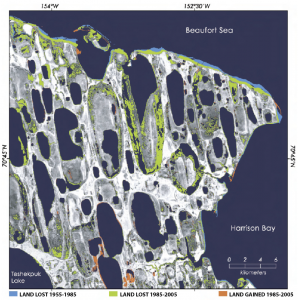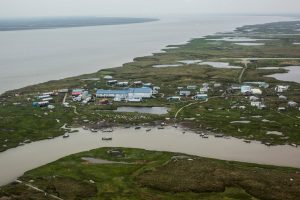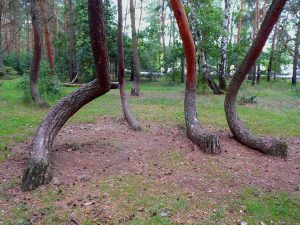MADELEINE YU | ONLINE REPORTER | SQ ONLINE 17-18
When people consider the effects of climate change, the catastrophic outcomes of the rapid melting of glaciers and ice sheets may immediately come to mind. This anxiety is understandable: just a 200mm increase in sea levels could displace thousands who live in coastal regions and exacerbate seasonal floods and tidal storms. However, there is another problem with equally devastating repercussions that has eluded popular awareness, and it lies just beneath the surface–the thawing of permafrost.
Permafrost is ground that has remained frozen solid for more than two years; it’s also assumed that it will remain this way indefinitely, hence the perma in the term. However, in Alaska and other northern regions around the globe, the usual conditions ideal for maintaining permafrost are changing as temperatures steadily increase. It is projected that by the year 2100, a significant portion of the upper five-and-a-half yards of the frozen ground will thaw. If Alaska’s permafrost completely melts, there will be devastating implications, not just locally, but on the global scale for years to come.
When the temperature of the permafrost is below 32°F, it is considered stable. However, over the last century, permafrost on the north slope of Alaska has warmed by 4-7°F. Thawing permafrost is highly prone to erosion due to increases in water from the melted ice around sediment. Scientists at the U.S. Geological Survey analyzed topographic maps compiled from aerial photographs and found that in the 20 year span between 1985-2005, land loss in the studied area more than doubled when compared to the 30 year span of 1955-1985.

Since nearly 90% of Alaska is covered by permafrost, the melting of the layer would mean that hundreds of communities would be uprooted as foundations beneath highways, railroads, airstrips, and buildings crumble. Newtok, a small village located near Alaska’s western coast is quickly eroding away. For the 400 civilians living there, their homes are no longer safe; however, estimates place the cost of relocating the entire village at $130 million. Last year, Alaska’s Senator Lisa Murkowski requested aid from the Federal Emergency Management Agency (FEMA), but because federal disaster relief isn’t meant to deal with the gradual impacts of climate change, the request was turned down.

Already, the rising temperatures disrupt the timing of the seasons and with it, the adaptive behaviors that animals use as protection from predators. At the same time, melting permafrost also has a direct effect on the organisms living above it. Throughout the lowland forests of Alaska, Canada, and northern Eurasia, drastically leaning and curved trees, aptly termed “drunken” trees, are becoming more prevalent as the thawing of permafrost continues. As the ground melts and sinks beneath them, there is less support to hold the trees vertically. Beyond their odd appearance, the leaning trees have become increasingly uninhabitable for the local wildlife.

Another important consideration is that as the permafrost melts, everything trapped within the soil is released. This includes a host of surviving microorganisms and chemical compounds compacted from many years, the release of which could have fatal results. Just in 2016, an outbreak of anthrax killed a 12-year-old boy and hospitalized hundreds in Siberia. The source was traced to spores of Bacillus anthracis released from thawed permafrost into the nearby soil and water.
A perhaps more insidious occurrence is that the melting of the permafrost will release the trapped carbon dioxide and methane within the soil and by doing so, contribute to the accumulation of greenhouse gases in the atmosphere. This may accelerate global warming far beyond our ability to reverse it.
In 2012, a study published in Nature described how sudden warming events were triggered by the release of carbon dioxide and methane from Antarctic permafrost around 50 million years ago. It is projected that within the century, the release of carbon from Alaska’s permafrost will increase carbon dioxide levels in the atmosphere by 3 times its current level. Once the permafrost has thawed, re-freezing the ground to a stable temperature below 32°F will be unrealistic with the release of carbon into the atmosphere nearly impossible to remedy.
In 2015, the Paris Climate Accord sought to reduce the thawing of the permafrost to 40%; however, in light of President Donald Trump’s withdrawal from the Paris agreement, there will be even less done to slow the thawing process.
Whether anything can be done to prevent the imminent thawing of Alaska’s permafrost is difficult to know for sure. One thing that is certain, however, is that the entire globe, and not just Alaska and other northern regions, will change. Steps must be taken as soon as possible to confront this accelerating issue for the sake of ourselves, our future generations, and the planet that we call home.
[hr gap=””]
Resources
- https://www.nytimes.com/interactive/2017/08/23/climate/alaska-permafrost-thawing.html
- https://www.cnbc.com/2017/08/23/thawing-alaska-permafrost-alarms-scientists.html
- http://www.bbc.com/future/story/20171016-the-great-thaw-of-americas-north-is-coming
- https://www.nature.com/articles/nature10929
- https://landsat.gsfc.nasa.gov/pdf_archive/cape_halkett_4web.pdf
- https://news.nationalgeographic.com/news/2014/04/140417-drunken-trees-melting-permafrost-global-warming-science/
- https://www.scientificamerican.com/article/as-earth-warms-the-diseases-that-may-lie-within-permafrost-become-a-bigger-worry/
- https://www.npr.org/2017/12/20/571914718/for-alaskan-coastal-village-erosion-hits-home

